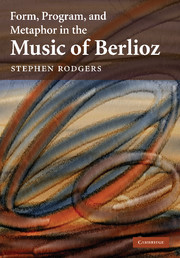Book contents
- Frontmatter
- Contents
- Music examples
- Figures
- Acknowledgments
- 1 Introduction
- 2 Preliminary examples and recent theories
- 3 Form as metaphor
- 4 Mixing genres, mixing forms: sonata and song in Le Carnaval romain
- 5 The vague des passions, monomania, and the first movement of the Symphonie fantastique
- 6 Love's emergence and fulfillment: the Scène d'amour from Roméo et Juliette
- 7 Epilogue
- Notes
- Bibliography
- Index
5 - The vague des passions, monomania, and the first movement of the Symphonie fantastique
Published online by Cambridge University Press: 27 June 2009
- Frontmatter
- Contents
- Music examples
- Figures
- Acknowledgments
- 1 Introduction
- 2 Preliminary examples and recent theories
- 3 Form as metaphor
- 4 Mixing genres, mixing forms: sonata and song in Le Carnaval romain
- 5 The vague des passions, monomania, and the first movement of the Symphonie fantastique
- 6 Love's emergence and fulfillment: the Scène d'amour from Roméo et Juliette
- 7 Epilogue
- Notes
- Bibliography
- Index
Summary
The maladies of the Symphonie fantastique
On April 16, 1830, Berlioz sketched out the program to the Symphonie fantastique in a letter to his friend Humbert Ferrand and then added these lines:
Now, my friend, this is how I have woven my novel, or rather my history, whose hero you will have no difficulty in recognizing … I conceive of an artist, gifted with a lively imagination, who, in that state of the soul which Chateaubriand so admirably depicted in René, sees for the first time a woman who realizes the ideal of beauty and fascination that his heart has so long invoked. By a strange quirk, the image of the loved one never appears before the mind's eye without its corresponding musical idea, in which he finds a quality of grace and nobility similar to that which he attributes to the beloved object. This double obsession [idée fixe] pursues him unceasingly. That is the reason for the constant appearance, in every movement of the symphony, of the main melody of the first allegro.
The first draft of the program found in this letter is strikingly similar to the subsequent versions that would appear with the symphony's score, particularly in its characterization of the malady that afflicts the symphony's protagonist.
- Type
- Chapter
- Information
- Form, Program, and Metaphor in the Music of Berlioz , pp. 85 - 106Publisher: Cambridge University PressPrint publication year: 2009



